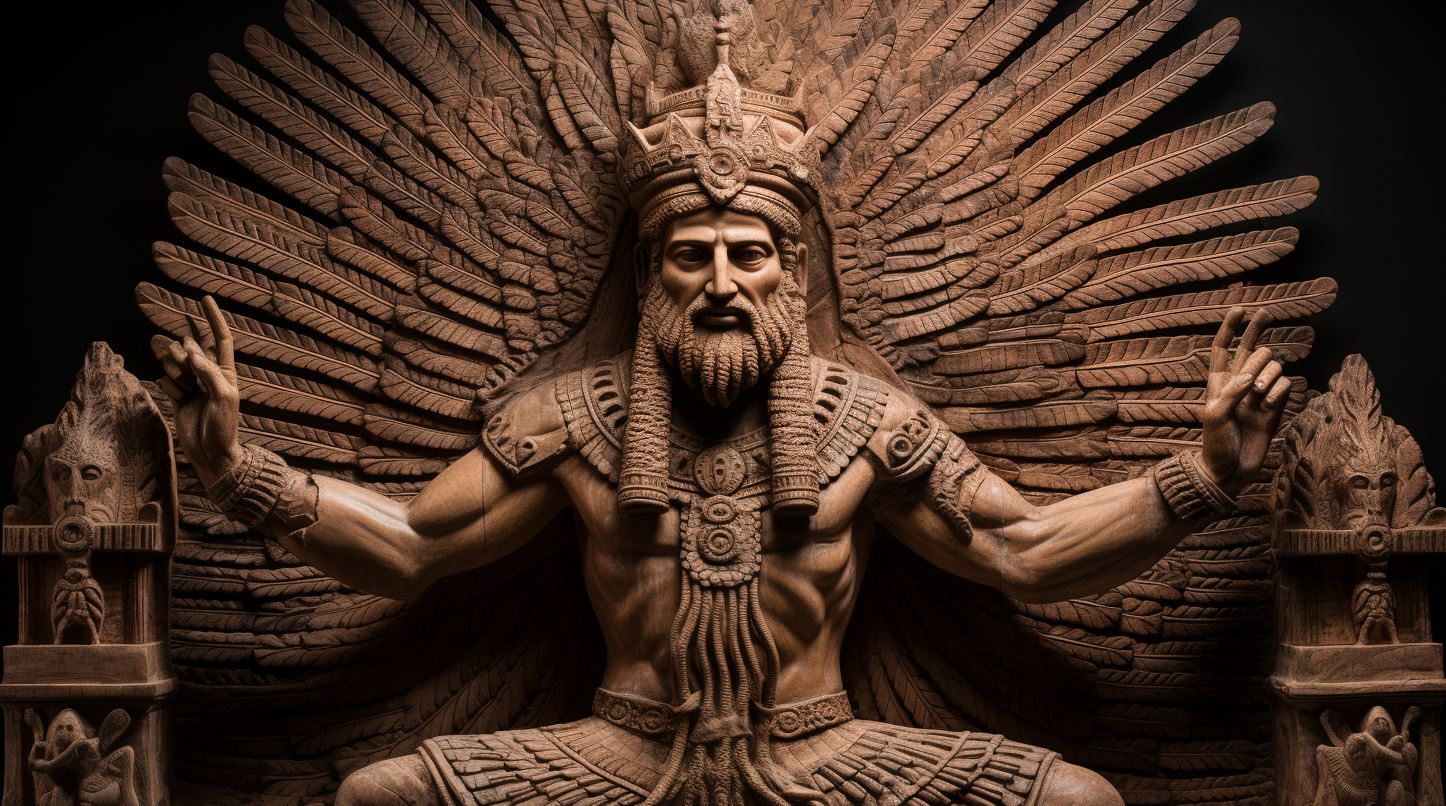Ninlil Goddess of Wind: Exploring the Mesopotamian Deity’s Power and Influence

Ninlil, the Mesopotamian goddess of wind, held significant roles and power in the ancient Sumerian pantheon. Revered for her connections to the earth, agriculture, and as the wife of the deity Enlil, Ninlil embodied strength and authority.
Her worship centered around temples, particularly in Nippur and Tummal, where she was venerated as a principal deity. This article provides an overview of Ninlil’s origins, her role as the goddess of wind, her relationship with Enlil, places of worship, and her enduring influence on Mesopotamian culture.
Origins of Ninlil: Exploring the Ancient Mesopotamian Deity
Welcome to the fascinating world of Ninlil, an ancient Mesopotamian deity whose origins and significance we will delve into. This section will shed light on the intricate interconnectedness of the Sumerian pantheon and Ninlil’s significant position within it.
Additionally, we will explore the captivating myths and stories that surround this revered goddess.
The Sumerian Pantheon and Ninlil’s Position
The Sumerian pantheon comprised a complex network of gods and goddesses, each with their distinct roles and attributes. Within this divine hierarchy, Ninlil held a prominent position as a powerful goddess associated with various aspects of life.
Her significance extended beyond her marriage to Enlil, showcasing her independent authority and influence. As we embark on this exploration, we will gain insight into the essential role Ninlil played in the ancient pantheon.
Myths and Stories Surrounding Ninlil
Mythology and stories offer a captivating glimpse into the ancient civilization’s beliefs and perceptions. Our journey into Ninlil’s origins wouldn’t be complete without uncovering the rich tapestry of myths and stories associated with her.
These narratives reveal the depth of her character, her interactions with other deities, and her impact on various aspects of human existence. Prepare to be enthralled by the tales that have transcended time and continue to shape our understanding of Ninlil.
By exploring the Sumerian pantheon and delving into the myths and stories surrounding Ninlil, we can gain a deeper appreciation for the ancient Mesopotamian deity’s origins and significance. Join us on this captivating journey as we unravel the mysteries of Ninlil, the illustrious goddess who left an indelible mark on the ancient world.
Role and Attributes of Ninlil: Unveiling the Power and Influence
Ninlil, the Mesopotamian goddess of wind, held significant roles and possessed immense power within the ancient Sumerian pantheon. Let’s delve into two key aspects of her role and attributes: her connection to the earth and agriculture, and her representation as the goddess of wind and air.
Ninlil’s Connection to the Earth and Agriculture
Ninlil’s significance extended beyond her association with the wind. She was intricately tied to the earth and played a vital role in the realm of agriculture. As a symbol of fertility and abundance, Ninlil was believed to facilitate the growth of crops and ensure bountiful harvests for the people of Mesopotamia.
Devotees worshiped Ninlil as the divine force behind the growth and sustenance of their agricultural endeavors. Farmers sought her blessings and favor to ensure prosperous yields, viewing her as a nurturing and benevolent deity who provided for their sustenance and well-being.
Ninlil as the Goddess of Wind and Air
In addition to her connection to the earth, Ninlil’s domain included the ethereal realm of wind and air. She held the significant title of the goddess of wind, embodying its power and influence over the world.
Believed to possess command over the wind’s direction and intensity, Ninlil was honored and revered as the force behind gentle breezes, life-giving winds, and even fierce storms. Her control over the winds signified her authority and dominion over the natural elements, making her a formidable figure in Mesopotamian mythology.
Through her dual roles as the goddess of wind and earth, Ninlil represented the delicate balance of nature and the interconnectedness of different elemental forces. Her influence was felt in every gust of wind and every seed that took root in the fertile soil, ensuring the cyclical nature of life’s abundance.
Stay tuned for the following sections as we explore the divine union between Ninlil and Enlil, their shared roles and synchronization with other deities, the places dedicated to worshipping Ninlil, and her enduring significance in Mesopotamian culture.
Ninlil and Enlil: The Divine Union of Power and Harmony
Within the ancient Mesopotamian pantheon, the relationship between Ninlil and Enlil held a significance that extended beyond their individual roles as deities. Their divine union represented a harmonious balance of power, authority, and fertility.
The Relationship between Ninlil and Enlil
Ninlil, as the wife of Enlil, played a crucial role in their divine relationship. She was not only an equal partner but also a nurturing force, complementing Enlil’s power and authority with her own qualities of fertility and maternal care.
Together, they embodied the fundamental forces of creation and sustenance.
Their union symbolized the vital connection between the heavens and the earth. Enlil, as the Lord of the Air, controlled the winds and brought forth life-sustaining rain, while Ninlil, as the goddess of wind and earth, represented the fertile ground that nurtured growth and abundance.
Shared Roles and Synchronization with Other Deities
Both Ninlil and Enlil shared many of the same roles and attributes, further reinforcing their divine partnership. They were both associated with the agricultural cycle, ensuring the prosperity and abundance of the land.
Additionally, their powers extended to the realm of authority and governance, exemplifying their status as powerful deities within the pantheon.
Furthermore, Ninlil’s synchronization with other goddesses, such as Sud, Ishtar of Nínive, and the wife of the supreme Assyrian god Ashur, highlighted her universal significance and influence.
It is important to note that while Ninlil and Enlil held their own distinct roles, their union represented the harmonious coexistence of masculine and feminine forces, reflecting the societal values and ideals of balance and unity.
- The divine union of Ninlil and Enlil embodied the balance of power and fertility.
- Ninlil played a nurturing role as Enlil’s wife, complementing his authority.
- They symbolized the connection between the heavens and the earth, controlling the forces of wind and rain.
- Both deities shared roles related to agriculture and governance.
- Ninlil’s synchronization with other goddesses highlighted her universal significance.
Understanding the divine bond between Ninlil and Enlil provides insights into the intricate belief systems and cultural values of the ancient Mesopotamians.
Their harmony as a couple represented the harmony of the natural world and the interconnectedness of the cosmic forces that shaped their lives and livelihoods.
Worship and Temples: Exploring the Places Devoted to Ninlil
Ninlil, the powerful Mesopotamian goddess of wind, was widely worshiped across various regions.
Devotees constructed magnificent temples to honor her and seek her blessings. Let’s delve into some of the prominent places devoted to Ninlil.
Nippur and its Principal Temple, Eki’ur
One of the primary centers of worship for Ninlil was the ancient city of Nippur. Here, the Eki’ur temple stood as the principal abode dedicated to the goddess. It served as a focal point for religious ceremonies, where rituals were performed to honor Ninlil’s divinity and seek her benevolence.
Located in the heart of Nippur, the grandeur of Eki’ur temple was unparalleled. Its monumental architecture and intricate designs showcased the significance and reverence accorded to Ninlil. Worshipers from near and far made pilgrimages to this revered sanctuary, presenting offerings and supplications to the goddess.
Ancient inscriptions found at Eki’ur reveal the deep devotion of the Mesopotamian people towards Ninlil. The temple served as a meeting place for religious scholars, priests, and worshipers, fostering a sense of community and spiritual unity.
Other Regions of Reverence for Ninlil
- Tummal: Another important site of worship for Ninlil was the city of Tummal. Nestled in its sacred boundaries, numerous temples and sanctuaries were dedicated to the goddess. These sacred spaces served as gathering points for religious festivals and ceremonies.
- Other Mesopotamian Cities: Beyond Nippur and Tummal, Ninlil’s influence extended to other cities across Mesopotamia.
Devotees in Uruk, Lagash, Ur, and other prominent urban centers constructed temples and shrines to pay homage to the goddess.
- Rural Areas: The reverence for Ninlil was not restricted to urban settlements alone – her worship transcended boundaries and reached the rural areas of Mesopotamia.
In villages and farming communities, local shrines and altars were established to seek the goddess’s blessings for agricultural prosperity.
The collective devotion expressed in these various places of worship exemplifies the profound impact Ninlil had on the lives and beliefs of the Mesopotamian people.
These sacred sites connected individuals from different walks of life, offering them a space for spiritual contemplation and connection with the divine. They stood as enduring testaments to the enduring legacy of Ninlil and her esteemed position within the Mesopotamian pantheon.
Legacy and Influence: Ninlil’s Enduring Significance
Ninlil’s Influence on Later Mesopotamian Culture
Ninlil’s impact on later Mesopotamian culture cannot be overstated. As the goddess of wind and air, she was revered for her role in controlling and guiding the elements, particularly in relation to agricultural success.
In addition to her connection to agriculture, Ninlil’s status as a principal deity and her union with Enlil elevated her importance in the pantheon. Her influence extended beyond religious worship and permeated various aspects of Mesopotamian society and belief systems.
Ninlil’s association with fertility and growth made her an integral part of religious rituals, especially those focused on ensuring prosperous harvests. Her symbolic representation as a mother deity and her role in the birthing of gods, such as Nergal, Nanna, and Ninurta, further solidified her influence in family and fertility-related matters.
Her presence in epic tales and myths showcased her power and authority, leaving an indelible mark on Mesopotamian literature and storytelling.
Understanding the Ongoing Study and Interpretation of Ninlil
The study and interpretation of Ninlil continue to captivate scholars and researchers in the field of Mesopotamian studies. As new archaeological discoveries unfold, experts uncover artifacts and inscriptions that shed light on the understanding of Ninlil’s significance within ancient societies.
Ongoing excavations in Nippur and other regions dedicated to Ninlil offer valuable insights into the cultural practices and beliefs associated with her worship.
Furthermore, the analysis of textual and visual representations of Ninlil provides valuable clues in deciphering her attributes, roles, and iconography. Scholars meticulously examine ancient texts, ranging from hymns, prayers, to myths, in an attempt to unravel the intricacies of Ninlil’s mythology and symbolism, deepening our understanding of Mesopotamian religious practices and cosmology.
- Exploration of Ninlil’s representation in art and sculpture
- Analyzing her role in creation myths and divine genealogies
- Comparative studies with other Mesopotamian goddesses to discern shared characteristics and roles
- Investigating her presence in magical and healing practices
As the study of Ninlil progresses, it opens up avenues for interdisciplinary research, drawing from fields such as archaeology, anthropology, linguistics, and religious studies.
This interdisciplinary approach allows for a more comprehensive understanding of Ninlil’s enduring significance and the cultural impact she had on ancient Mesopotamia.
In conclusion, Ninlil’s legacy and influence in Mesopotamian culture have left an indelible mark. Her role as the goddess of wind and air, her connection to agriculture, and her esteemed position in the pantheon solidified her status as a powerful and integral deity.
The ongoing study and interpretation of Ninlil provide valuable insights into ancient Mesopotamian beliefs, practices, and the significance of divine female figures in their society.
.



















